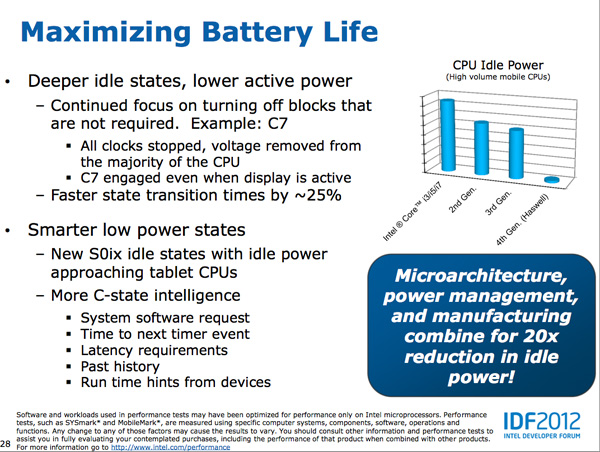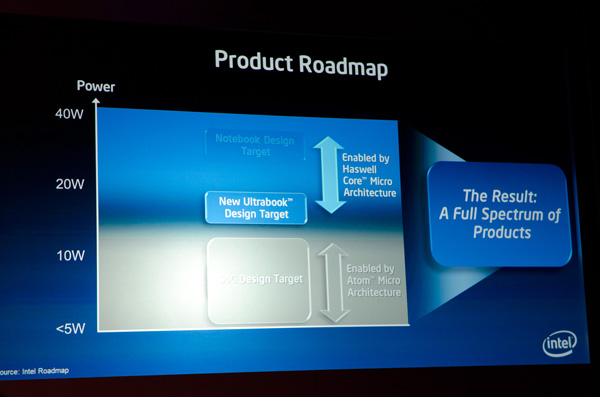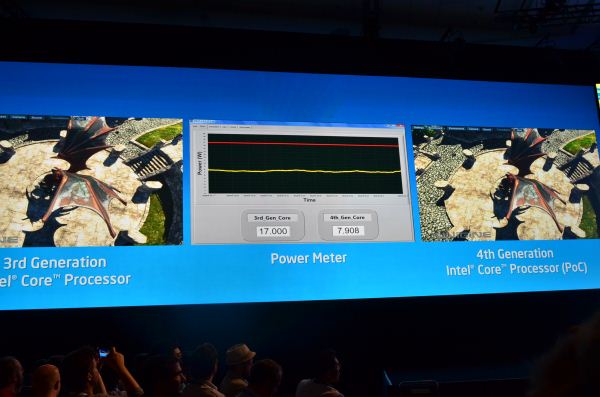Intel's Haswell Architecture Analyzed: Building a New PC and a New Intel
by Anand Lal Shimpi on October 5, 2012 2:45 AM ESTOther Power Savings
Haswell's power savings come from three sources, all of which are equally important. We already went over the most unique: Intel's focus on reducing total platform power consumption by paying attention to everything else on the motherboard (third party controllers, voltage regulation, etc...). The other two sources of power savings are more traditional, but still very significant.

At the micro-architecture level Intel added more power gating and low power modes to Haswell. The additional power gating gives the power control unit (PCU) more fine grained control over shutting off parts of the core that aren't used. Intel published a relatively meaningless graph showing idle power for standard voltage mobile Haswell compared to the previous three generations of Core processors.
Haswell can also transition between power states approximately 25% faster than Ivy Bridge, which lets the PCU be a bit more aggressive in which power state it selects since the penalty of coming out of it is appreciably lower. It's important to put the timing of all of this in perspective. Putting the CPU cores to sleep and removing voltage/power from them even for a matter of milliseconds adds up to the sort of savings necessary to really enable the sort of always-on, always-connected behavior Haswell based systems are expected to deliver.
Intel has also done a lot of work at the process level to bring Haswell's power consumption down. As a tock, Haswell is the second micro-architecture to use Intel's new 22nm tri-gate transistors. The learnings from Ivy Bridge are thus all poured into Haswell. Intel wasn't too specific on what it did on the manufacturing side to help drive power down in Haswell other than to say that a non-insignificant amount of work came from the fabs.
The Fourth Haswell
At Computex Intel's Mooly Eden showed off this slide that positioned Haswell as a 15-20W part, while Atom based SoCs would scale up to 10W and perhaps beyond:
Just before this year's IDF Intel claimed that Haswell ULT would start at 10W, down from 17W in Sandy/Ivy Bridge. Finally, at IDF Intel showed a demo of Haswell running the Unigen Heaven benchmark at under 8W:
The chain of events tells us two things: 1) Intel likes to play its cards close to its chest, and 2) the sub-10W space won't be serviced by Atom exclusively.
Intel said Haswell can scale below 10W, but it didn't provide a lower bound. It's too much to assume Haswell would go into a phone, but once you get to the 8W point and look south you open yourself up to fitting into things the size of a third generation iPad. Move to 14nm, 10nm and beyond then it becomes more feasible that you could fit this class of architecture into something even more portable.
Intel is being very tight lipped about the fourth client Haswell (remember the first three were desktop, mobile and ultra-low-volt/Ultrabook) but it's clear that it has real aspirations to use it in a space traditionally reserved for ARM or Atom SoCs.
One of the first things I ever heard about Haswell was that it was Intel's solution to the ARM problem. I don't believe a 10W notebook is going to do anything to the ARM problem, but a sub-8W Haswell in an iPad 3 form factor could be very compelling. Haswell won't be fanless, but Broadwell (14nm) could be. And that could be a real solution to the ARM problem, at least outside of a phone.
As I said before, I don't see Haswell making it into a phone but that's not to say a future derivative on a lower power process wouldn't.













245 Comments
View All Comments
rundll - Friday, October 5, 2012 - link
Four cores and 95 W tdp.What is this?
meloz - Friday, October 5, 2012 - link
Yes this caught my eye and I would like an answer, too.Maybe it is one SKU with GT3 for desktop? Or maybe it is a 6 core part?
Or maybe.....it is the mother of all overclocking processors. Muhahahahah!
Kevin G - Friday, October 5, 2012 - link
I suspect that 95W is the rated socket limit. This is similar to how Intel advertises Ivy Bridge at 77 W on the desktop but tells motherboard manufacturers to build around the higher 95 W figure.What is odd is that Haswell will move some of the VRM circuitry on the package which should restrict just how far off that 95W figure motherboards can deviate.
meloz - Friday, October 5, 2012 - link
What a great article, Anand!Felt so good to read a 'proper' Anandtech article after so long, instead of the usual Apple worship and cheap fillers.
Haswell is looking very good. Would make an ideal upgrade for Sandy Bridge users. AMD is done, but thankfully Intel sees some threat from ARM so that will keep them innovating.
I hope Intel make a sensible choice with Haswell SKUs and get away from their artifical crippling and segmentation tendencies. That's about the only thing that can ruin Haswell.
Wolfpup - Friday, October 5, 2012 - link
Once again they bump up the number of transistors being used on their worthless video-and this time they even lower CPU performance (L3 cache) to appease their worthless video.Interesting article, but I guess I misunderstood previous articles...I thought Conroe through Ivy Bridge had 4 integer execution units per core? (As does Piledriver?)
haukionkannel - Friday, October 5, 2012 - link
Good article and information that you need win 8 to fully utilize Haswell was new information to me. It will be interesting to see how much better Haswell will be with win 8 compared to win 7. Seems to be same kind of dilemma as with AMD Bulldoser/piledriver where there seems to be some kind of better performance with new OS, but how much will reamain to be seen.Belard - Friday, October 5, 2012 - link
Apple owns various CPU tech and design companies such as P.A. Semi. They can build their own CPUs (not x86 of course)...Apple will do what they can to take out the middleman.
jwcalla - Friday, October 5, 2012 - link
Apple doesn't have any fabs though and if Samsung isn't willing to re-sign another contract, they're going to be in a bit of a bind. In other words, it won't be cheap. And even if Samsung does re-up, you can be sure that it'll come with an additional $1.05b price tag to offset any "losses" in their mobile division.I felt the first page overestimated Apple's influence quite a bit. They have ~5% desktop marketshare and 0% in the server space. Not to trivialize any loss in CPU sales, but Intel's primary headwinds don't involve a possible Apple switch to ARM.
Kevin G - Friday, October 5, 2012 - link
Apple's influence comes from the mobile market which is beginning to dwarf the PC market (and is larger than the server market in terms of volume). Apple is the largest tablet maker and a major smart phone manufacturer. There hardware is backed by one of the largest digital media markets. To do this Apple is the worlds largest consumer of flash memory whom orders are large enough to directly affect NAND pricing.With the rest of the industry going ultra mobile, they'll have to compete with Apple who is already entrenched. Sure the PC will survive but mainly for legacy work and applications. Their isn't enough of a PC market in the future to be viable long term with so many players.
jwcalla - Friday, October 5, 2012 - link
While all this is true, the first page seems to indicate that Intel is really pushing the low power envelop partly because of rumors that Apple will move away from Intel chips in their laptop / ultrabook products.While I'm sure Intel is happy to be in MBAs, etc., losing that business isn't going to be as big a deal as the other pressures facing the PC market (as you mention).
Now if WinRT on ultrabooks / laptops began to take off... that would be a huge problem for Intel.